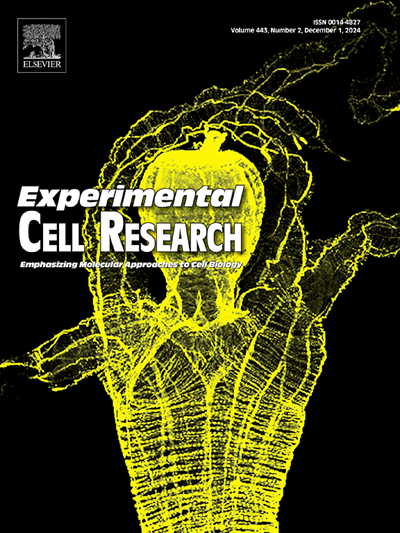COPS5通过上调KHSRP促进Per2 mRNA衰变来调节骨肉瘤的进展
IF 3.3
3区 生物学
Q3 CELL BIOLOGY
引用次数: 0
摘要
骨肉瘤(OS)是一种常见的骨肉瘤,常见于儿童和青少年。本研究深入研究了COP9信号体亚基5 (COPS5)、kh型剪接调节蛋白(KHSRP)和周期生物钟2 (Per2)在骨肉瘤细胞恶性表型中的复杂调控网络。CCK-8法检测细胞增殖情况。选择伤口愈合或transwell试验来评估细胞迁移或侵袭。流式细胞术检测细胞凋亡。Co-IP和GST-pull - down决定了COPS5和KHSRP之间的相互作用。通过RNA-pull - down和RIP检测KHSRP与Per2 mRNA的相互作用关系。我们发现,COPS5敲低可抑制OS细胞的增殖、迁移和侵袭,并促进细胞凋亡。COPS5基因的敲低也抑制了裸鼠肿瘤异种移植模型的肿瘤生长。COPS5与KHSRP相互作用,维持KHSRP蛋白的稳定性。此外,KHSRP与Per2 mRNA之间存在结合关系。此外,COPS5通过介导KHSRP对Per2 mRNA的衰减作用,促进OS细胞的肿瘤发生。总的来说,COPS5通过接触和介导KHSRP促进Per2 mRNA的衰变,从而促进OS的进展。我们的研究揭示了COPS5作为OS中的关键调制器。本文章由计算机程序翻译,如有差异,请以英文原文为准。
COPS5 regulates osteosarcoma progression by upregulating KHSRP to promote Per2 mRNA decay
Osteosarcoma (OS) is a common bone sarcoma that is often seen in children and adolescents. This study delves into the intricate regulatory network involving COP9 signalosome subunit 5 (COPS5), KH-type splicing regulatory protein (KHSRP), and Period circadian clock 2 (Per2) in the context of osteosarcoma cell malignant phenotype. CCK-8 assay was applied to assess cell proliferation. Wound healing or transwell assay was selected to evaluate cell migration or invasion. Apoptosis was determined employing flow cytometry assay. Co-IP and GST-pull down determined the interaction between COPS5 and KHSRP. The interaction relationship between KHSRP and Per2 mRNA was detected by RNA-pull down and RIP assays. We found that COPS5 knockdown repressed proliferation, migration, and invasion and facilitated apoptosis of OS cells. Knockdown of COPS5 also restrained the tumor growth in the nude mice tumor xenograft model. COPS5 interacted with KHSRP to maintain the protein stability of KHSRP. Furthermore, there was a binding relationship between KHSRP and Per2 mRNA. Besides, COPS5 promoted OS cell tumorigenesis by mediating the decay effect of KHSRP on Per2 mRNA. Collectively, COPS5 promoted the decay of Per2 mRNA via contacting and mediating KHSRP, thereby facilitating OS progression. Our study unveils COPS5 as a key modulator in OS.
求助全文
通过发布文献求助,成功后即可免费获取论文全文。
去求助
来源期刊

Experimental cell research
医学-细胞生物学
CiteScore
7.20
自引率
0.00%
发文量
295
审稿时长
30 days
期刊介绍:
Our scope includes but is not limited to areas such as: Chromosome biology; Chromatin and epigenetics; DNA repair; Gene regulation; Nuclear import-export; RNA processing; Non-coding RNAs; Organelle biology; The cytoskeleton; Intracellular trafficking; Cell-cell and cell-matrix interactions; Cell motility and migration; Cell proliferation; Cellular differentiation; Signal transduction; Programmed cell death.
 求助内容:
求助内容: 应助结果提醒方式:
应助结果提醒方式:


